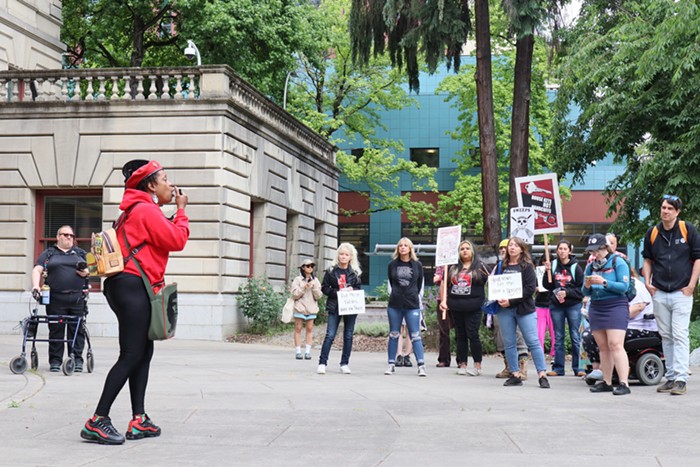LOOKING AT REACTIONS to Tip Toland's sculptures is almost as interesting as the sculptures themselves. Responses are strong: disgust, fascination, wincing. Clearly, this is a show about empathy and affect.
The first glimpse of Toland's exhibit at the Portland Art Museum (PAM) is mild—just a peek of toes. As you edge along the hallway, soon you spot a 10-foot-long nude made of clay, lying on an orange pedestal. The brochure tell us she is Tanzanian; she is titled "Africa." She looks up; she has a blank but wide-eyed expression. Five busts, each nearly three-feet tall, surround her on pedestals. They are scrawny, pale children, with startled and hurt expressions. The walls are painted brown, offset by the white matte of the busts.
Toland is a regional artist based in Vaughn, Washington. The six pieces in her APEX exhibit (APEX is an ongoing series at PAM that features Northwest artists) are an extension of her career-long exploration of the grotesque and the hyperrealistic.
Hyperrealism, as a genre, has a history of exposing social injustice. It approaches audiences with uncomfortable subjects using a familiar lens—that is, realism. For example, some might remember Duane Hanson's piece "The Dishwasher" (1973), a sculpture of a weary, slumped-over kitchen worker that used to reside in the contemporary wing of PAM. Hanson's work draws attention to minutiae: It makes you look closely at the mannerisms and malaise of the American working class. By contrast, Toland's work points to a more distant culture and class.
The subjects of Toland's sculptures are Tanzanians with albinism, a skin condition that results in lack of pigment. In Tanzania, persecution of people with albinism is well documented. Some Tanzanians believe individuals with albinism have magical powers, and so albinos are maimed, their mutilated body parts used by witch doctors to make potions. Others believe albinos are cursed, and they are murdered as a result. Toland's APEX exhibit addresses these these tragedies.
Toland's career spans 40 years, and her talent and technique show. These six sculptures—all completed this year—are meticulous: They're fired in the kiln in segments, then pieced together with epoxy cement. Pastel is rubbed on top of acrylic house paint, creating masterful illusions of freckled faces and subtle skin contours to create specific individuals. The eyes of the sculptures are hazel; often they're crossed, or diverted in two directions. Their lips are parted in a slight gap, and between them is the blackest void. Their synthetic hair builds up to a perfect, carefree texture.
If the work didn't have such character, this exhibit might be an exercise in ogling, in othering its African subjects. But each piece has a personality; their features were taken from photographic references of Tanzanian children. One sculpture depicts a girl with closed eyes who looks like she's wincing at a camera flash—it encapsulates a distinct moment. The titles of the sculptures are literal, physical descriptions of individuals: "African Teen with Albinism," "African Child with Albinism."
The scale of Toland's work is what really drives the point home. If you look at the sculptures long enough, you get vertigo from their size; it's difficult to look at this work and not feel moved. The fact that something so massive can appear so fragile and delicate is a testament to Toland's craft, and to the potential of art to make us look at something bigger, something beyond ourselves.













